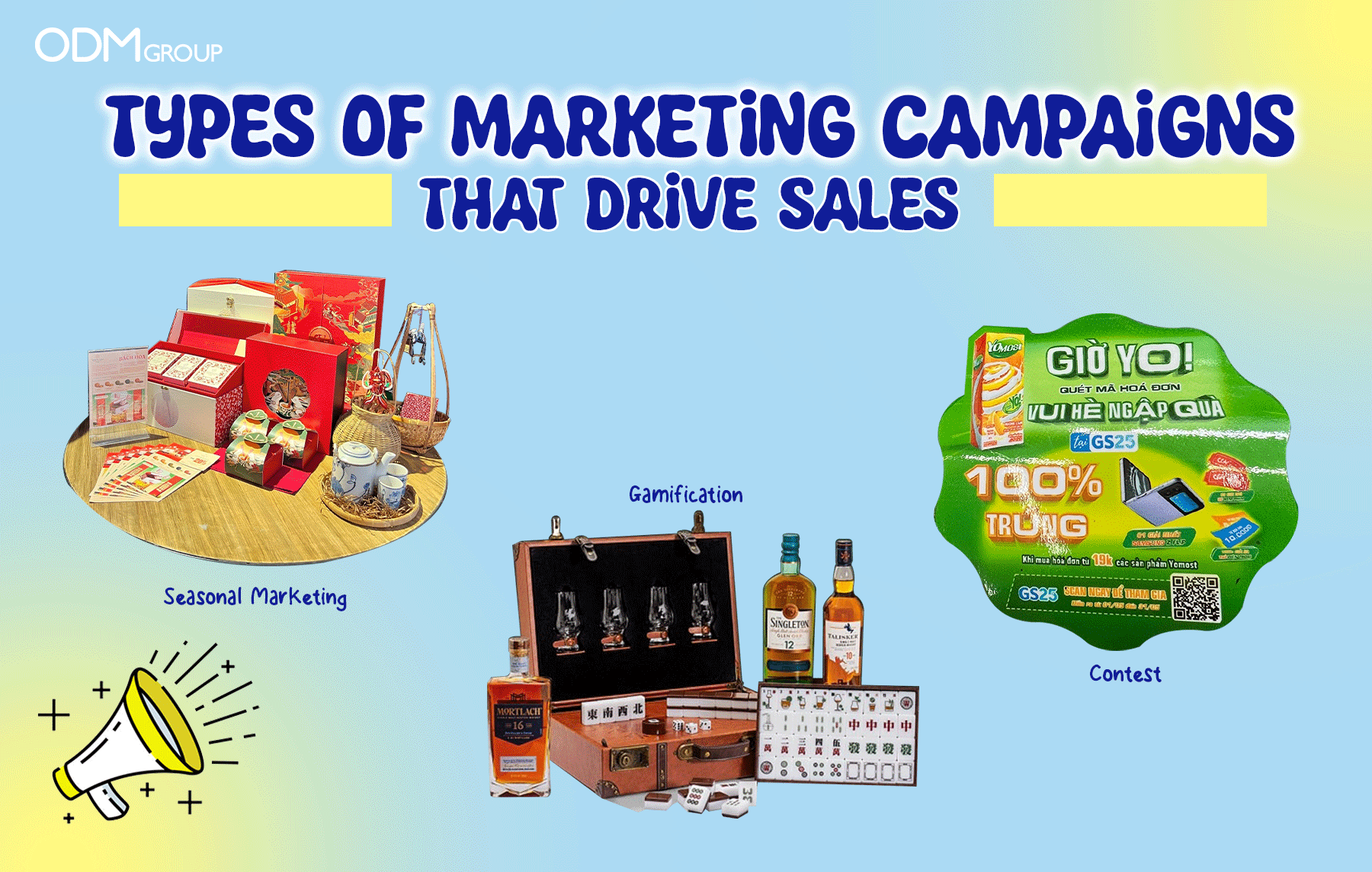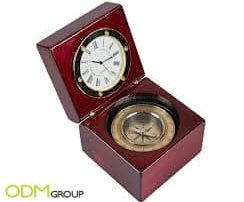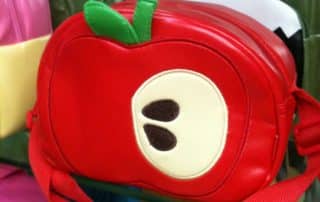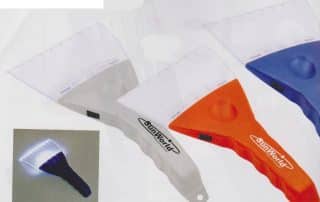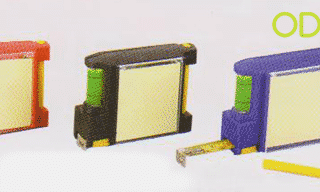Businesses can use various marketing campaigns, distribution channels, and messaging to attract customers and drive conversions.
Understanding the strengths and nuances of these marketing types is crucial when launching new products, boosting brand awareness, and increasing ROI.
With so many options, choosing the right campaign can be overwhelming. But fear not—the ODM Group has got your back.
We’ve compiled a detailed list of ten marketing campaigns to help you drive sales. Additionally, we’ve included some successful marketing samples for inspiration.
So stay tuned and get ready to learn the process. This will help you make informed decisions about your next campaign.
What are Marketing Campaigns?
Marketing campaigns are meticulously planned and executed strategic activities to promote a product, company, service, or brand through various channels.
These campaigns are executed through digital platforms, social media, advertisements, and public relations to deliver a clear, persuasive message to a specific target audience.
The main goal is to enhance brand recognition, generate interest, and prompt desired actions such as purchases, leads or sign-ups.
Successful marketing campaigns use creative storytelling, eye-catching visuals, and clear communication to connect with customers, recognise the company’s brand, build reputation, and achieve measurable results.
The Elements of Marketing Campaigns
When planning and implementing marketing campaigns, you have to consider the following elements.
Goals
Goals or objectives are important for aligning efforts, tracking progress, and achieving desired outcomes. Examples include boosting brand awareness, generating leads, and driving sales.
Key Performance Indicators (KPIs)
The campaign’s objective should be clear and measurable. KPIs are metrics used to track your campaign’s progress and success. They can be conversion rate, customer acquisition cost, brand reach, conversion rates, or engagement metrics. For example, if your objective is to generate leads like signing up for a service or purchasing a product, measuring your conversion rate could let you know if you have an effective webpage.
Budget
Strategic budget planning and allocation benefit marketing campaigns. These provide insights into prioritising spending across channels and maximising the ROI (Return-on-investment).
Target Audience
You can tailor messages, offers, and strategies by identifying your target audience’s demographics, behaviours, motivations, and pain points.
Selecting Channel Platforms
Explore various digital and traditional marketing channels, such as social media, email, TV, print ads, or events, and their advantages and drawbacks. Your chosen channel should align with your campaign objectives and cater to your target audience’s preferences.
Creative Assets
Your marketing campaign should capture attention and deliver messages effectively. Create visually appealing graphics, engaging videos, stimulating ad materials, and compelling copy that convey the campaign’s message.
Content Formats
Seasoned marketers understand the importance of using multiple formats in a single campaign to increase brand awareness. They don’t limit themselves to social media alone. Instead, they adopt a comprehensive marketing strategy, including emails, videos, printed ads, blog posts, user-generated content, and events.
Your content format should be based on audience preferences, platform requirements, and campaign goals.
Right Team
Collaboration and involving the right people with the necessary skills and expertise are components of a successful marketing campaign. Highlight the roles, responsibilities, and potential team members in planning, executing, and evaluating the campaign.
Timing and Scheduling
Seasonal trends, customer behaviour patterns, and competitor activities significantly impact the campaign’s effectiveness. Make sure your campaign coordinates with your target audience’s peak receptivity and purchasing intent.
Competitors
Tracking and analysing competitor activity during marketing campaigns cannot be overstated. Asses their messaging, tactics, and customer engagement, to identify opportunities and stay ahead of the game.
Now, let’s jump into what you came for – different types of marketing campaigns used successfully by big and small brands alike.
Top 10 Benefits of Marketing Campaigns
Successful marketing campaigns can bring many benefits to your product promotion,
Here are the top 10 benefits that your businesses can obtain using the right campaign:
1. Increased Brand Awareness:
Marketing campaigns spread the word about a brand, making it more recognisable to potential customers.
When prospective customers hear, see or watch your creative and effective advertisement, they will get familiar with your company’s branding and messaging. This familiarity can lead to consideration of your products or services when they need something from your offer.
A well-executed marketing campaign can increase brand awareness, helping your business establish a strong foothold in the market and stand out from the competition.
2. Increased Customer Loyalty
Attractive marketing campaigns, valuable information, discounts, and high-quality products and services can create brand loyalty among consumers.
When customers feel appreciated and valued, they are more likely to return in the future and recommend your business to others.
3. Increased Sales Volumes
Marketing campaigns are versatile tools that serve multiple purposes. They promote products or services, help establish your brand identity, engage with customers on a personal level, and provide you valuable insights that inform future strategies. When executed effectively, these campaigns can convert leads into new customers and increase overall revenue and market position.
4. Targeted Reach
Strategic campaigns can efficiently reach specific segments of the market. You can target audiences based on demographics, interests, behaviours, and more, ensuring that your messages reach the right audience.
5. Improved Customer Engagement
Marketing campaigns allow businesses to engage with their audience through social media, interactive content, and direct communication. This engagement helps to build a loyal community around the brand, resulting in increased customer engagement.
6. Improved Customer Retention
Marketing is about attracting new customers and retaining existing ones. Campaigns focused on loyalty programs, customer appreciation, and engagement can significantly increase customer retention rates.
7. Enhanced Brand Positioning
Brand positioning refers to establishing a unique identity and reputation for a brand in the minds of its target audience compared to its competitors. This involves defining the brand’s values, beliefs, and characteristics and communicating why it is a superior choice for customers.
With marketing campaigns, you can express and strengthen your position within the market. You can effectively communicate a brand’s desired identity through careful planning, strategic messaging, connection, execution, and adjustment based on feedback.
8. Competitive Advantage
Highlighting unique selling points and value propositions in marketing campaigns can make your brand stand out from the competition.
9. Market Insights
Marketing campaigns generate valuable data on customer preferences and behaviour. Analyzing this data helps your business refine its product offerings, marketing strategies, and customer experience.
10. Adaptability and Learning
You can test different messages, channels, and strategies with marketing campaigns to see what works best. The adaptability and continuous learning process help your business evolve with your market and stay relevant.
Marketing campaigns provide the benefits mentioned above and build the foundation for long-term brand strength and customer relationships.
10 Common Types of Marketing Campaigns
Tactic Led Marketing Campaigns
1. Seasonal Marketing/Seasonal Push Campaigns
Marketing your brand during high consumer engagement periods is a smart strategy. Tailoring your marketing approach to fit customers’ mindsets can lead to increased brand engagement.
San Fu Lou, also known as the House of Three Blessings, is a great example of a brand that excels in seasonal marketing. They have executed impressive seasonal marketing campaigns, exemplified in their Mid-Autumn Festival promotion.
The Mid-Autumn Festival is a significant cultural event in Vietnam and San Fu Lou creates a festival wonderland within its restaurant to celebrate this occasion. They set up a designated booth with a mesmerising display to showcase its Nguyen Ngoc Bach Hoa mooncake collection.
They adorn their mooncakes in custom-designed, exquisite packaging that reflects the essence of the festival. These beautifully crafted boxes add sentiment and charm to any gift-giving occasion.
It’s important to cater your product offerings, promotions, and messaging with specific holidays, emphasising the themes and emotions associated with each one.
It’s not just about your words; the visual appeal is equally important. So pay attention to the visual aspects of your branding, as this can make all the difference and give your brand the edge during the season.
You can create unique packaging or displays that will catch the eye and add value to your offerings.
Seasonal gifts with purchases are an effective way for brands to add value to their products and enhance the customer experience during specific times of the year. Brands can motivate customers to purchase by offering limited-time deals that create a sense of urgency and excitement.
Somersby Cider in China is a great example of a brand that excels in seasonal gift-with-purchase marketing. During the winter season, the brand offers branded glass as a gift with purchase. This practical and useful item is a constant reminder of the brand after customers use it for a long time. This helps build brand awareness and engagement, increasing customer loyalty.
KiteKat Russia is a great example of using seasonal marketing through promotional gifts. They created a Christmas advent calendar for their cat food products. This clever idea helps build excitement up to Christmas day while promoting daily engagement with the brand. KiteKat Russia provides a daily advent calendar to strengthen the emotional connection between customers and their feline companions so they can share moments of joy.
Seasonal promotions with gifts stimulate the excitement of a particular time of year and connect it with the brand’s values. They influence the purchasing decisions of customers.
2. Influencer Marketing
Influencer marketing is a form of social media marketing where brands collaborate with influencers to promote their products or services to their followers. While celebrity endorsements used to dominate this field, social content creators with niche audiences offer significant value to brands today. These micro-influencers often have highly engaged followers on various social media platforms.
If you still have doubts about the effectiveness of influencer marketing, consider a survey by Civic Science, which revealed that 14% of 18-to-24-year-olds and 11% of millennials had purchased within the past six months based on a recommendation from a blogger or influencer.
As of now, Instagram remains the platform of choice for social influencers. According to eMarketer, 76.6% of U.S. marketers will utilise Instagram for their influencer campaigns in 2023. However, pay attention to TikTok as a potential platform for influencer marketing.
Brands can use influencer marketing as a powerful strategy to engage with their target audience and generate business results. This involves working with social media content creators with a large following and influence in their communities. By doing so, brands can tap into the trust and loyalty that these communities have built and effectively promote their products or services. To make the most of influencer marketing, we recommend staying up-to-date with platform trends and carefully selecting the right influencers for your brand.
3. Gamification Campaigns
Gamification campaigns are marketing strategies that use interactive and rewarding experiences to engage consumers. These campaigns come in different forms, such as gamified loyalty programs or interactive quizzes. Simple game elements are often used, like points that users can earn by winning games or purchases. These points can then be exchanged for discounts or free items.
One notable example of successful gamification campaigns in the alcohol industry is the Jameson Whiskey’s scratch-off game, where customers can win prizes and discounts. The campaign was designed to intrigue and reward its customers. This promotional strategy involved producing scratch cards, allowing consumers to win prizes ranging from branded merchandise to exclusive discounts. The game was simple yet engaging, exploiting human curiosity and the drive for reward.
Diageo, a global leader in beverage alcohol, also leveraged gamification to promote its Single Malt Whiskey range in Hong Kong. Customers were enticed with a limited edition offer—a set including a Diageo Whiskey Tasting and Mahjong Set, available upon purchasing HK$4,800 worth of their premium whiskey. This unique promotion added value to the purchase and created a sense of exclusivity and excitement among consumers.
This initiative exemplifies how gamification can elevate traditional marketing strategies, making brands more relatable, interactive, and appealing to consumers.
4. Anti-advertising Marketing Campaign
Certain brands like the iconic Marmite adopt a unique marketing approach known as “anti-marketing campaigns”. Anti-marketing campaigns use reverse psychology and sarcasm to engage their target audience instead of traditional marketing techniques that try to showcase products and businesses in a positive light.
These campaigns offer a refreshing change from the usual practice of constant selling. By acknowledging the controversy surrounding their products/services, brands can build an honest and relatable connection with their customers.
Marmite Brand’s yeast extract spread elicits extreme opinions, so they embraced the division with their famous slogan, “Love it or hate it.” This straightforward statement confronts the fact that not everyone will be a fan, creating intrigue and sparking consumer conversations. What a wise strategy, right?
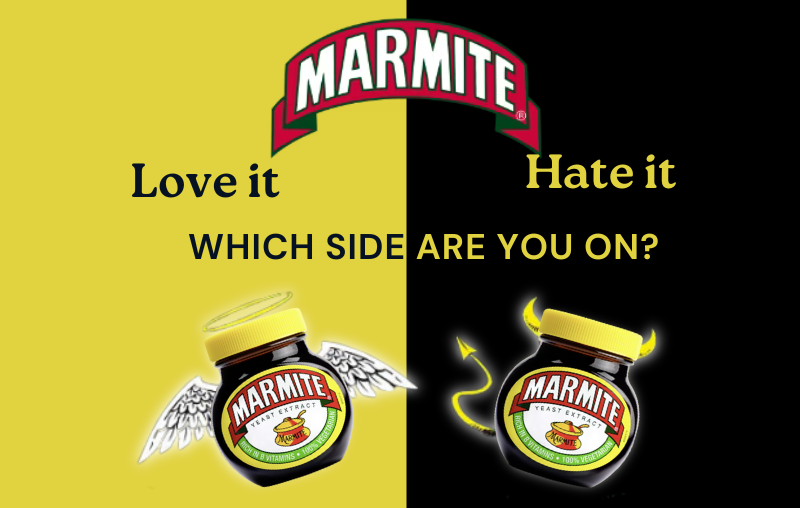
Anti-marketing campaigns have been successful in attracting attention, creating buzz, and establishing brand identity. An honest and authentic approach to advertising can help brands differentiate themselves and leave a lasting impression on their target audience.
Nowadays, transparency and authenticity are highly valued. Anti-advertising marketing campaigns help brands to connect with consumers more deeply because these campaigns embrace diverse opinions and preferences.
5. Contest Marketing Campaigns
A contest marketing campaign is a powerful strategy that uses contests and giveaways to increase brand visibility and connect with potential customers. This marketing technique taps into consumers’ desire for free items or rewards, capturing attention and generating excitement.
This campaign helps brands promote their products and services, increase brand awareness, conduct market research, and attract new leads through social competition. When people participate in contests, they are usually motivated by the chance to win exciting prizes.
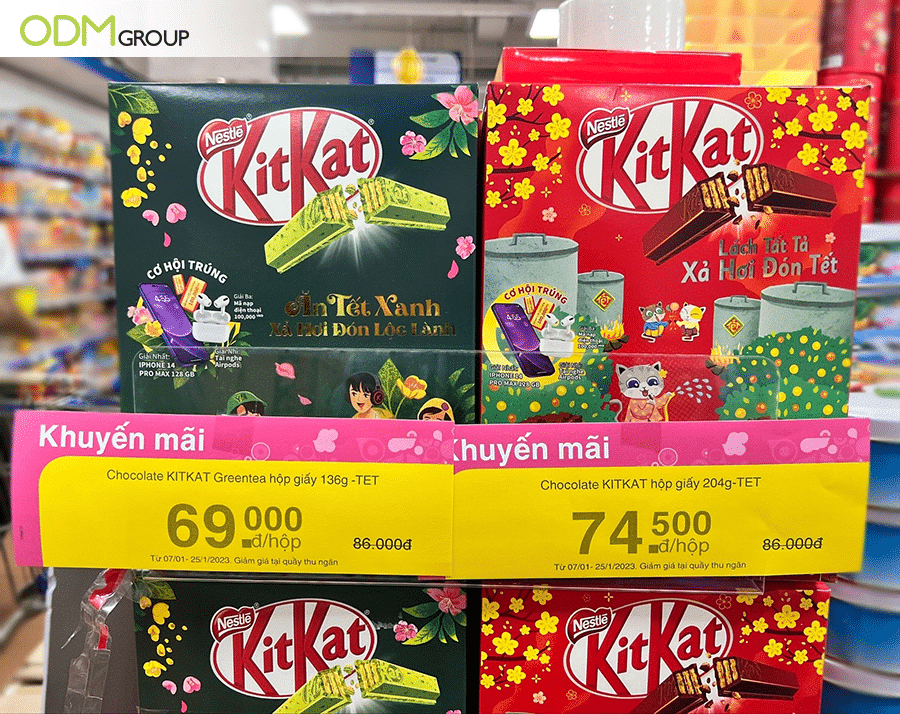
KitKat’s Promotional Contest in Vietnam is a successful example of contest marketing that effectively engaged the brand’s target audience and enhanced its brand awareness. The contest ran in various stores in Vietnam during the TET holiday period. To enter, shoppers had to purchase a KitKat Green tea 136g-TET and KitKat 204g-TET.
The promotion offered highly coveted rewards such as iPhone 14 Pro Max (1st prize-28 winners), Airpod Pro Headphones (2nd prize-40 winners), and mobile phone charge code 100,000 VND (3rd prize-400 winners). Customers were thrilled to participate in the contest, eagerly anticipating the chance to win. Kitkat’s contest created a buzz that was hard to ignore, leaving customers eager for more.
The brand’s creative packaging designs were perfectly aligned with the TET holiday and highlighted Vietnamese traditions and festivities. KitKat’s product display was also eye-catching and stood out in the stores, featuring a cardboard cut-out with the contest prizes.
Participating in the contest was made easy by texting a special code found at the back of the packaging via SMS.
KitKat’s Promotional Contest was a success. It enabled the brand to connect with its target audience, promote its TET holiday offerings, and increase brand loyalty.
6. Collaboration/Collaborative Marketing
Collaboration marketing, or co-branding, is a strategy in which similar or like-minded organisations collaborate to create campaigns or products to increase brand exposure, awareness, and leads.
Strategic partnerships expand brands’ reach and audience by blending their collective strengths, resulting in mutually beneficial outcomes. When collaborating, brands can use various marketing approaches. For instance, they can co-produce social media posts or launch new products targeting both brands’ audiences.
One key advantage of collaborative projects is their ability to help organisations identify and address current brand weaknesses. For example, when two companies come together for a co-branded campaign, it may bring to light that one company has a robust customer management system but limited data analysis capabilities. In contrast, the other company is an expert in data analysis. They can combine their strengths and collaborate to improve data collection and analysis to fill the gaps in each other’s processes by collaboration.
A great example of successful collaboration marketing can be found in the Lunar New Year promotion by Gifts at Races, a merchandise shop under The Hong Kong Jockey Club. They partnered with South Korean artist Mr. Soo Min Kim® (@fseo) to create the 2022 “Lucky New Year Designer Collection.” This collaboration brought together the artistic flair and unique style of Mr. Soo Min Kim® with the reputation and reach of Gifts at Races.
The “Lucky New Year Designer Collection” featured a range of eye-catching souvenirs adorned with Mr. Soo Min Kim®’s adorable horse race-related illustrations, incorporating a playful “spot-the-difference” element. The collection featured items that captured the essence of the Lunar New Year while appealing to a broad audience. The Lucky Dice Squeezy Health Ball was designed to relieve stress during the excitement of a horserace, while the creatively designed Lai See Envelopes symbolised luck and embraced traditional gifting traditions.
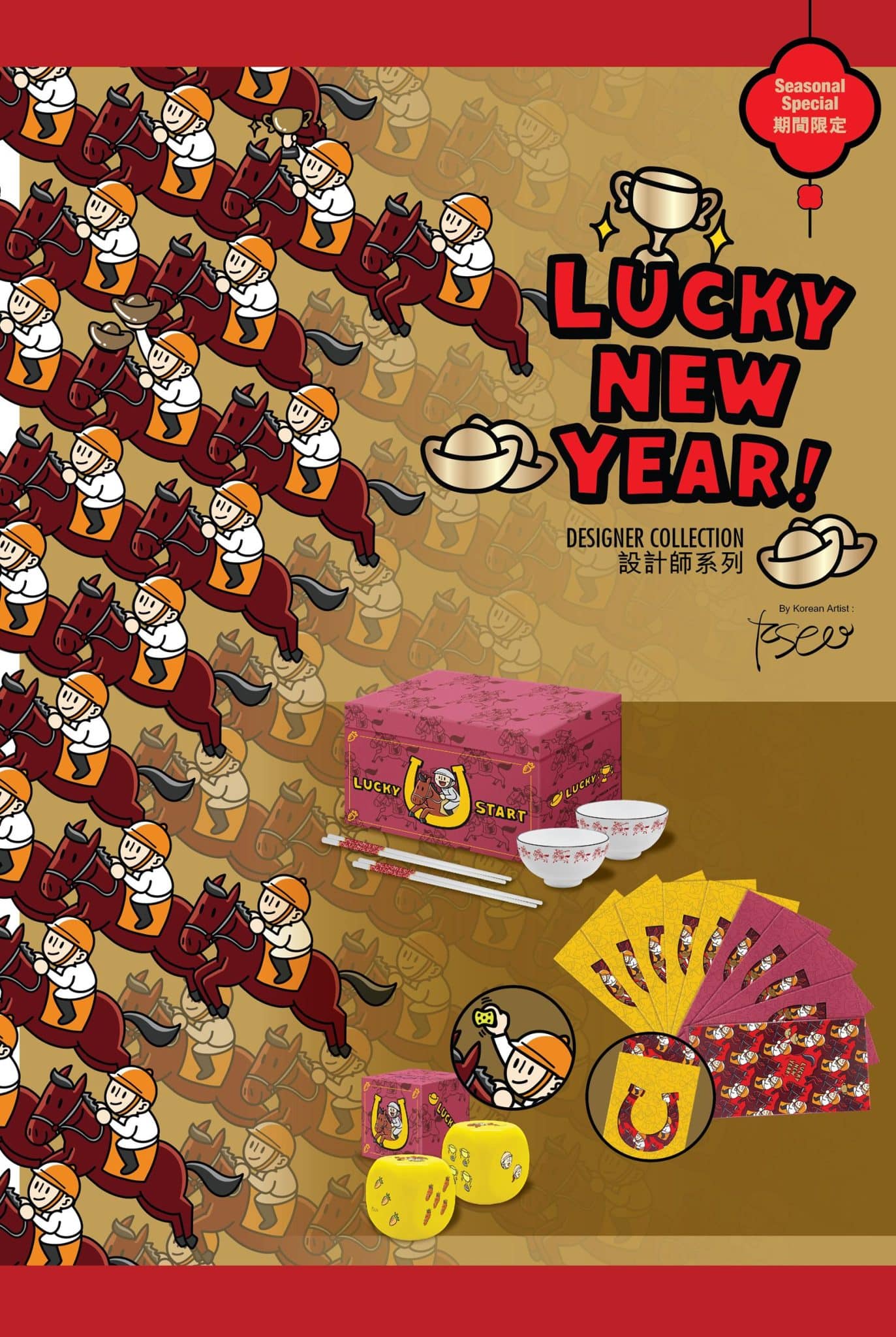
7. Guerilla Marketing
Guerrilla marketing is a low-cost strategy. The goal is to create a buzz around a brand or product and encourage consumers to share their experiences. It is inspired by guerrilla warfare, which uses unconventional tactics to overthrow traditional methods.
This marketing campaign often occurs in public areas and includes mediums like street art, graffiti or stencils, public installations, flash mobs, and experiential marketing.
One example of successful guerrilla marketing is Blendtec’s viral campaign, “Will It Blend?” The blender manufacturer created a series of YouTube videos showcasing its blenders, blending everything from marbles to iPhones and even iPads. The videos went viral and generated millions of views globally, becoming a significant talking point.
Objective-designed Marketing Campaigns
8. Brand Awareness and Branding Campaign
Brand awareness refers to consumers’ familiarity with a particular brand. Businesses often employ brand awareness campaigns to capture the public’s attention and differentiate themselves from the competition.
One notable example highlighting the effectiveness of brand awareness campaigns is the success story of McCafe, a Chinese coffee brand. McCafe recently launched a coffee promotion campaign to enhance brand recognition and encourage product trials.
A key element of this campaign was the use of point-of-sale (POS) displays. POS displays offer maximum exposure to products, catching the customer’s eye and driving impulse purchases. They also serve as a tool for product differentiation, giving brands a competitive edge.
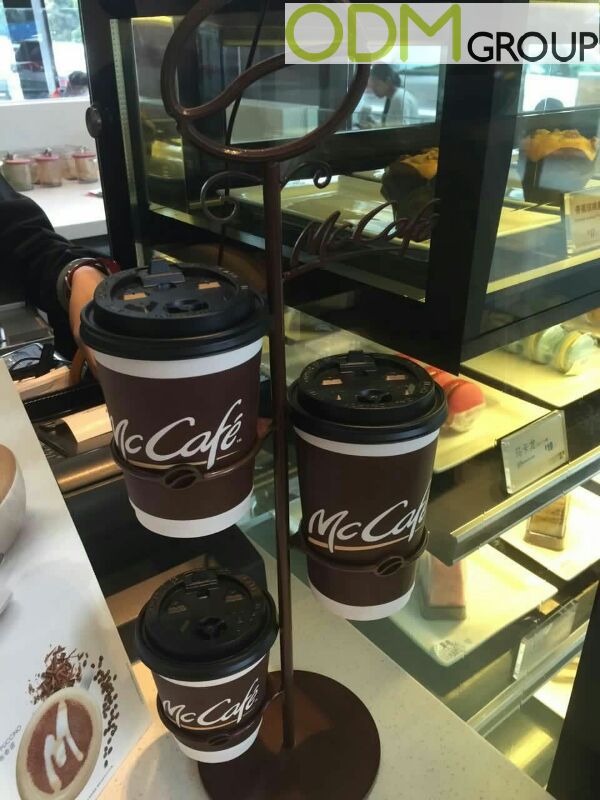
POS display should align with the brand’s image and convey its message effectively. McCafe’s POS displays utilised a simple yet visually appealing design that showcased their product at its best.
Tip: This design consistency reinforces the brand image and creates a positive attitude.
In addition, Nescafe, a well-known brand in the coffee industry, has effectively used brand awareness campaigns to grab consumers’ attention. They have implemented innovative strategies, such as branded coffee cups. These cups serve as functional items for customers and act as walking advertisements, spreading brand awareness wherever they are used.
9. Product Promotion Campaigns
A product promotion campaign is a targeted form of advertising designed to promote a specific product. Unlike broader marketing campaigns, this type focuses on customers with a clear idea of the product they seek. The goal is to capture their attention and provide them with immediate access to the product they desire.
The promotional products industry has many terms that clients should know before planning a promotion. To simplify the process of creating promotional products, a glossary is available to help understand these terms and provide tools for improving future marketing campaigns. Familiarising with these options can enhance flexibility and effectiveness in promotional efforts.
Miniso, a well-known international brand, executes one fantastic example of a successful product promotion campaign. This brand uses creative promotional to captivate customers of all ages. The spotlight is on its reversible soft toys, which may appear ordinary at first glance but offer a unique twist.
The advantages of this product set Miniso apart from its competitors in the market:
1. Added Value: Customers are drawn to additional value products. Miniso’s 2-in-1 soft toys grant customers the benefits of both designs, giving the product a higher perceived value.
2. Cost-saving: By producing 2-in-1 products, Miniso effectively reduces manufacturing costs and wastage. This strategic approach boosts efficiency and caters to customers’ desire for practicality.
3. Eye-Catching: Unconventional and unique designs always pique curiosity. By differentiating their products, Miniso builds brand loyalty and awareness, eliminating competitors in the same industry.
Miniso furthers this innovative concept through reversible soft toy designs for different occasions, such as the Year of the Pig and Year of the Cow. Because of this reversibility design, Miniso established a strong brand reputation and generated additional revenue.
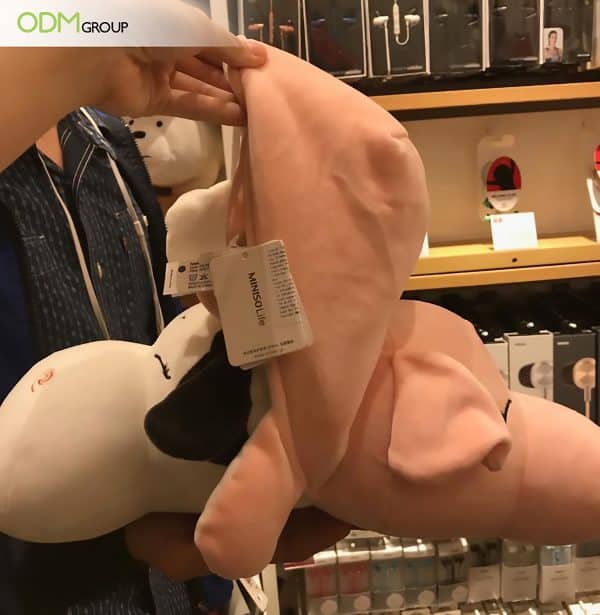
10. Rebranding Campaigns
Rebranding marketing campaigns are strategic plans to update, refresh, and revamp a company’s public image. The goal is establishing a new brand identity and effectively communicating a company’s values to its target market.
This type of marketing involves a complete overhaul of the company’s visual identity and collateral materials, including logos and symbols, packaging design, website design, and advertising materials. Through this transformational process, a company can reshape its brand and capture the attention of both existing and potential customers, improving its brand image.
Starbucks, a renowned global coffee chain, exhibits one remarkable example of a successful rebranding campaign. In 2011, Starbucks decided to modify its iconic logo, which had been used for over 19 years. This change of logo represented a significant shift in their brand identity.
The new logo featured a simplified design: the circle holding the famous brand name “STARBUCKS COFFEE” was removed, a mermaid image was enlarged, and the background switched from black to green. This rebranding initiative aligned with Starbucks’ intention to celebrate its 40th anniversary and streamline its brand presence.
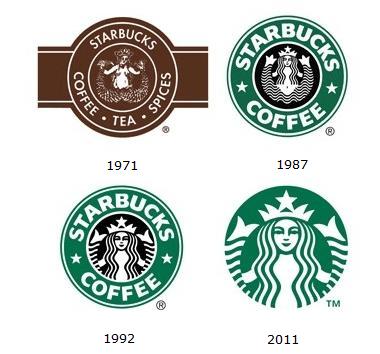
The Starbucks case study exemplifies how rebranding can be a powerful marketing strategy. Starbucks removed “coffee” from its logo to signal expansion beyond its traditional offerings and explore new channels, sparking customer conversations.
Rebranding campaigns are not solely about aesthetics. They should adapt to changing market dynamics, revitalise their image, and reflect on their evolving business strategies.
A well-executed rebranding effort can help a company:
Establish a Stronger Connection: Updating a company’s visual identity can create a fresh, engaging image that resonates with the target audience. This connection establishes brand loyalty and attracts new customers.
Reflect New Values: Rebranding enables companies to communicate their new values, emphasising their dedication to innovation, sustainability, social responsibility, or any other core principles they want to convey.
Reach New Markets: A rebranding campaign can help companies enter new markets or appeal to different demographics.
Tip: A rebranding campaign should not negatively impact existing customers’ decision-making process. Carefully navigate the transition to ensure that the changes in your visual identity are well-received. This can be achieved through effective communication and maintaining product quality.
Our Key Takeaways About The Different Types of Marketing Campaigns
Regardless of the type of marketing campaign you choose, creativity, strategic planning, and a deep understanding of the target audience can help deliver tangible results. And remember, you don’t have to handle it alone.
Partnering with a reliable, customized promotional products and solutions company like The ODM Group can elevate your marketing efforts.
For more marketing tips and ideas, please read our FAQs and blogs below.
Types of Marketing Campaigns FAQs
All you need to know about types of marketing campaigns!
How do I choose the right type of marketing campaign for my business
Selecting the right type of marketing campaign depends on your business goals, target audience, budget, and resources. Consider factors such as your marketing objectives, brand positioning, and the channels that are most effective for reaching your audience.
Do I need to use multiple types of marketing campaigns for my business?
Using a mix of marketing campaigns can be advantageous as it allows you to reach different segments of your target audience and leverage various channels for maximum exposure and engagement. Tailor your marketing strategy to incorporate different types of campaigns based on your objectives.
How can I measure the success of my marketing campaigns?
To measure the success of your marketing campaigns, set clear objectives and key performance indicators (KPIs) upfront. Track metrics such as conversion rates, click-through rates, engagement levels, and ROI to evaluate the effectiveness of your campaigns and make data-driven decisions for future strategies.
